SMART CABLES
HARNESSING TELECOMMUNICATION CABLE INFRASTRUCTURE TO MONITOR THE 71% OF EARTH NOT ACCESSIBLE BY LAND
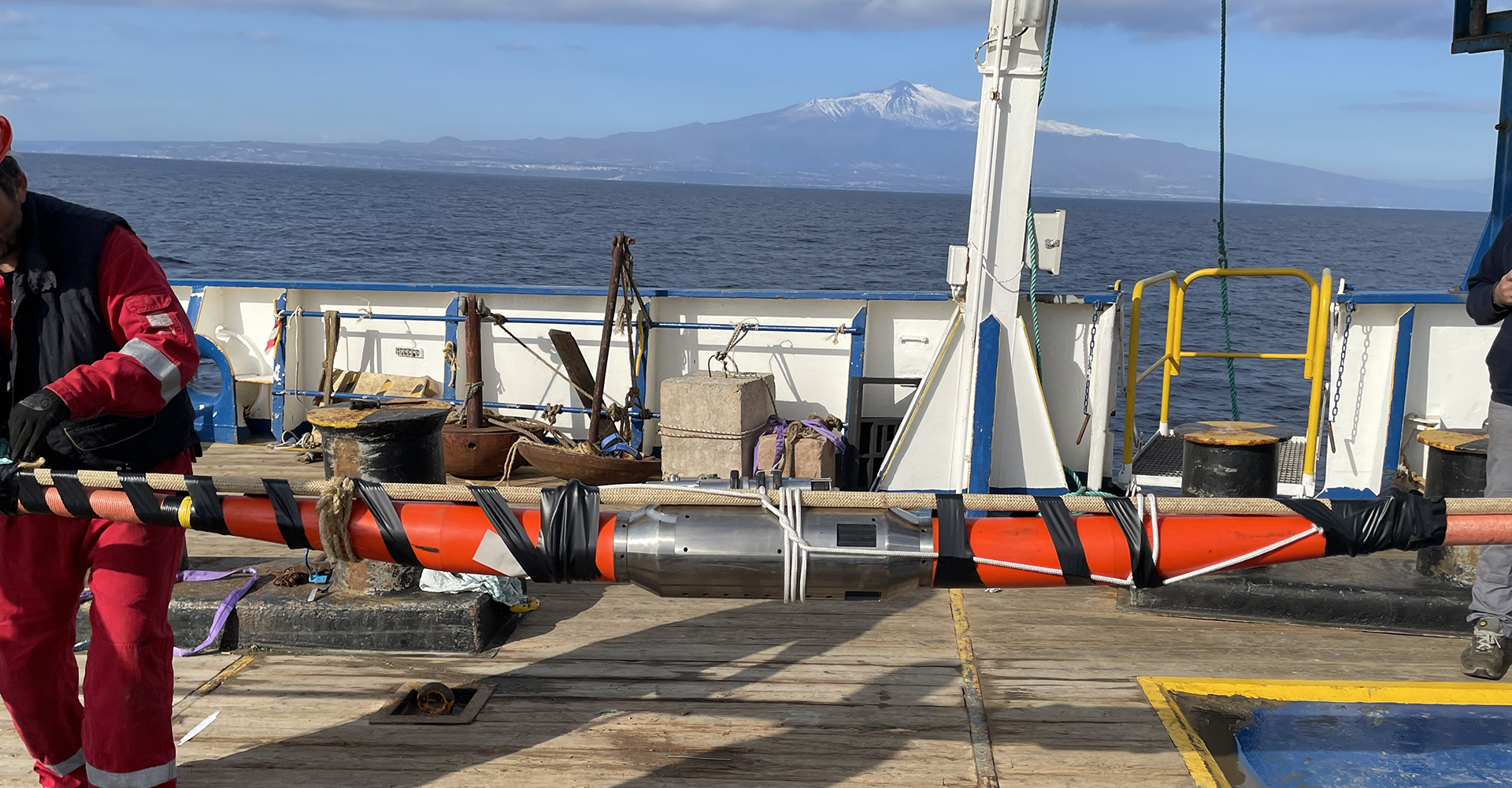
SMART CABLES
HARNESSING TELECOMMUNICATION CABLE INFRASTRUCTURE TO MONITOR THE 71% OF EARTH NOT ACCESSIBLE BY LAND

Our 30 years + extensive experience in developing broadband seismic ocean floor instrumentation led directly to our recent success in designing and deploying the World's first SMART cable system in 2023.
Our 30 years + extensive experience in developing broadband seismic ocean floor instrumentation led directly to our recent success in designing and deploying the World's first SMART cable system in 2023.
READ OUR SMART CABLE BROCHURE
WHY SHOULD YOU CHOOSE GÜRALP FOR YOUR SMART CABLE PROJECT?
Flexible instrumentation
Versatile and easy-to-deploy instrumentation for challenging conditions
Pioneering first SMART cable deployment
We succesfully deployed 21 km of cable with fully instrumented repeaters in the Western Ionian Sea in 2023
True broadband seismic instrumentation
Maximise the data quality for research applications
A full ocean observatory
Experienced with deploying a wide range of multi-disciplinary sensors to create ocean floor observatories

Flexible instrumentation
Versatile and easy-to-deploy instrumentation for challenging conditions
Pioneering first SMART cable deployment
We succesfully deployed 21 km of SMART cable with fully instrumented repeaters in the Western Ionian Sea in 2023

True broadband seismic instrumentation
Maximise the data quality for research applications
A full ocean observatory
Experienced with deploying a wide range of multi-disciplinary sensors to create ocean floor observatories
30+ years ocean bottom experience
Our experienced team have detailed understanding of the limitations and challenges associated with monitoring seismicity from the ocean floor
Full design capability
We offer a comprehensive design service for developing an instrumented SMART cable solution that meets the criteria of your project
30+ years ocean bottom experience
Our experienced team have detailed understanding of the limitations and challenges associated with monitoring seismicity from the ocean floor
Full design capability
We offer a comprehensive design service for developing an instrumented SMART cable solution that meets the criteria of your project
ABOUT

WHAT IS A SMART CABLE?
Historically, the deployment of oceanographic sensors with real-time communications has proven to be demanding in terms of budget, deployment and support requirements.
SMART (Science Monitoring and Reliable Telecommunications) cables are telecommunications cables designed to deliver real-time remote sensing of the ocean floor alongside traditional telecommunication objectives.
A global SMART Cable initiative has been exploring a number of ways in which these sensors could be integrated into commercially standard telecommunication cables to create SMART cable systems.
SMART (Science Monitoring and Reliable Telecommunications) cables are telecommunications cables designed to deliver real-time remote sensing of the ocean floor alongside traditional telecommunication objectives.
A global SMART Cable initiative has been exploring a number of ways in which these sensors could be integrated into commercially standard telecommunication cables to create SMART cable systems.
WHAT IS A SMART CABLE?

Historically, the deployment of oceanographic sensors with real-time communications has proven to be demanding in terms of budget, deployment and support requirements.
SMART (Science Monitoring and Reliable Telecommunications) cables are telecommunications cables designed to deliver real-time remote sensing of the ocean floor alongside traditional telecommunication objectives.
A global SMART Cable initiative has been exploring a number of ways in which these sensors could be integrated into commercially standard telecommunication cables to create SMART cable systems.
SMART (Science Monitoring and Reliable Telecommunications) cables are telecommunications cables designed to deliver real-time remote sensing of the ocean floor alongside traditional telecommunication objectives.
A global SMART Cable initiative has been exploring a number of ways in which these sensors could be integrated into commercially standard telecommunication cables to create SMART cable systems.
WORLDS' FIRST SMART CABLE
In December 2023, Güralp, working with Istituto Nazionale di Geofisica e Vulcanologia (INGV), successfully deployed the Worlds first ‘SMART Cable’ to monitor seismic activity and tsunami risk in the Ionian Sea.
The 'demonstrator' project proved that, with the appropriate selection of instruments, cable repeaters could be retrospectively fitted with seismic instrumentation; laid using traditional cable laying methods and; coupled sufficiently with the sea-floor to deliver good quality seismic data.
READ THE FULL CASE STUDY
The 'demonstrator' project proved that, with the appropriate selection of instruments, cable repeaters could be retrospectively fitted with seismic instrumentation; laid using traditional cable laying methods and; coupled sufficiently with the sea-floor to deliver good quality seismic data.
READ THE FULL CASE STUDY
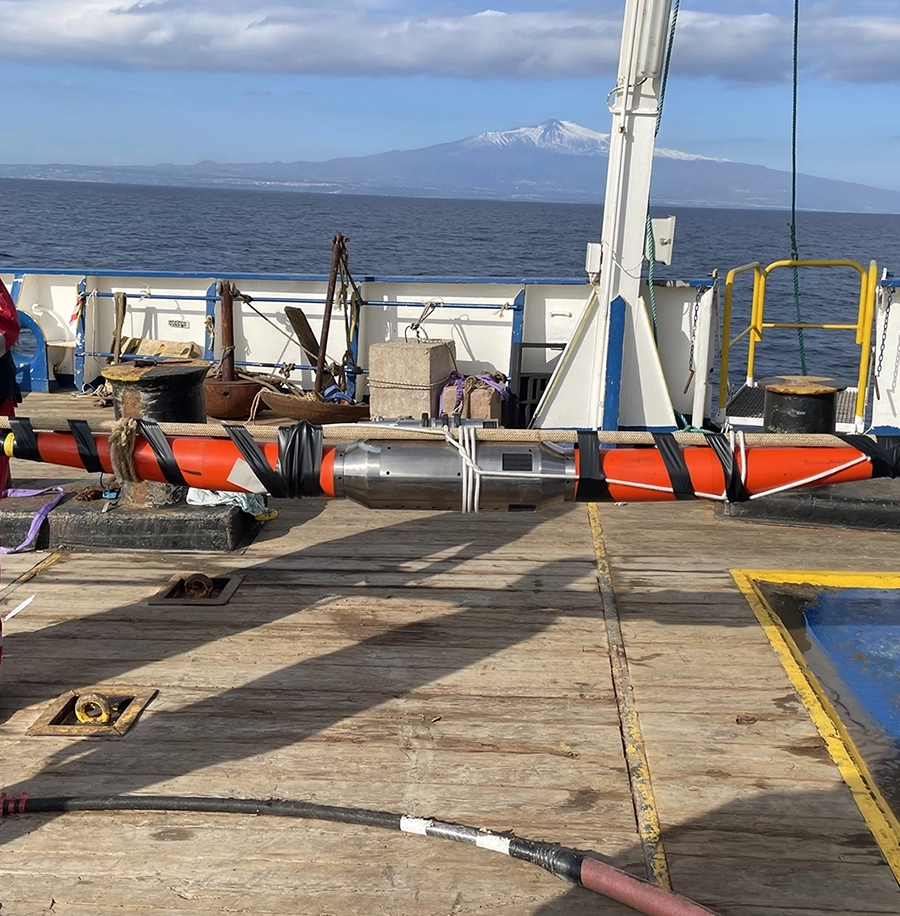
WORLDS' FIRST SMART CABLE

In December 2023, Güralp, working with Istituto Nazionale di Geofisica e Vulcanologia (INGV), successfully deployed the Worlds first ‘SMART Cable’ to monitor seismic activity and tsunami risk in the Ionian Sea.
The 'demonstrator' project proved that, with the appropriate selection of instruments, cable repeaters could be retrospectively fitted with seismic instrumentation; laid using traditional cable laying methods and; coupled sufficiently with the sea-floor to deliver good quality seismic data.
READ THE FULL CASE STUDY
The 'demonstrator' project proved that, with the appropriate selection of instruments, cable repeaters could be retrospectively fitted with seismic instrumentation; laid using traditional cable laying methods and; coupled sufficiently with the sea-floor to deliver good quality seismic data.
READ THE FULL CASE STUDY
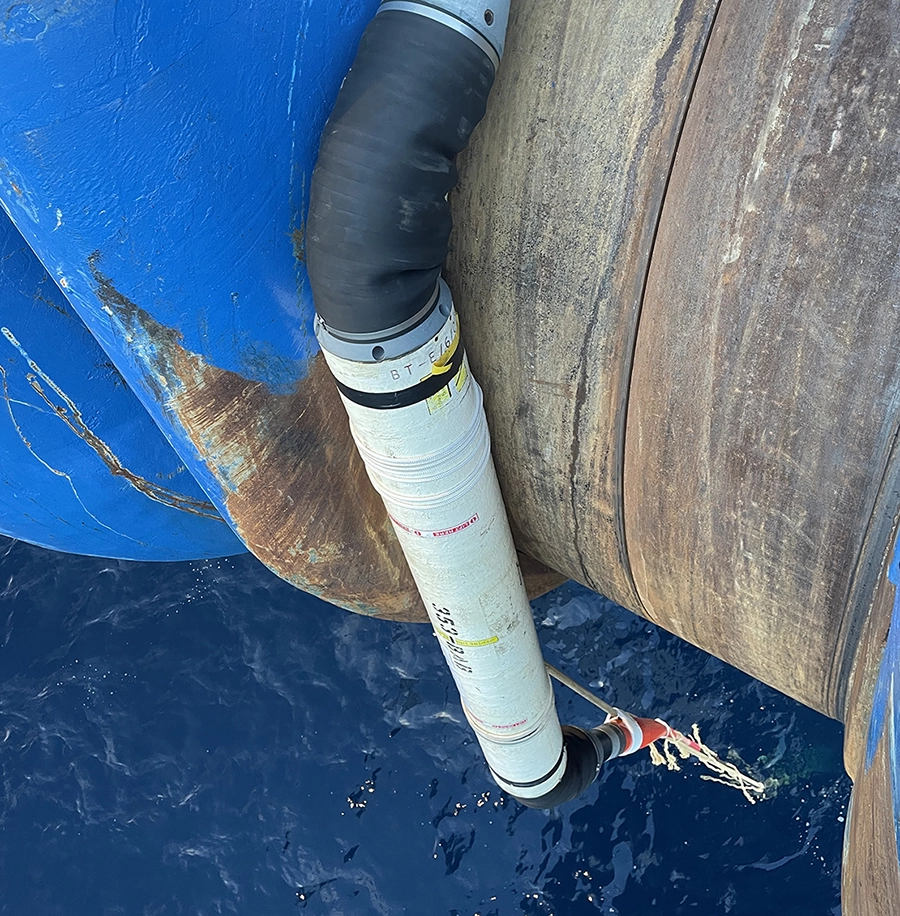
THE IMPORTANCE OF
INSTRUMENT SELECTION
As SMART cables are deployed from the surface to deep on the seafloor via a cable-laying vessel, their final resting position or bearing is not fully controllable.
Traditional broadband seismic sensors can withstand a tolerance of just a few degrees from level, or they require gimbals that will re-orientate them. Güralp’s broadband seismometer addresses this issue using novel and unique technology.
Traditional broadband seismic sensors can withstand a tolerance of just a few degrees from level, or they require gimbals that will re-orientate them. Güralp’s broadband seismometer addresses this issue using novel and unique technology.
THE IMPORTANCE OF
INSTRUMENT SELECTION

As SMART cables are deployed from the surface to deep on the seafloor via a cable-laying vessel, their final resting position or bearing is not fully controllable.
Traditional broadband seismic sensors can withstand a tolerance of just a few degrees from level, or they require gimbals that will re-orientate them. Güralp’s broadband seismometer addresses this issue using novel and unique technology.
Traditional broadband seismic sensors can withstand a tolerance of just a few degrees from level, or they require gimbals that will re-orientate them. Güralp’s broadband seismometer addresses this issue using novel and unique technology.
ADVANCED SENSOR TECHNOLOGY
We have developed unique omni-directional seismic sensors cable of delivering high quality seismic data regardless of the angle they are deployed at and without the need for mechanical gimbals.
This feature makes them the ideal choice for challenging deployments such as cable deployments from a ship. We also have demonstrable success with these same sensors in our traditional ocean bottom systems with excellent results.
In addition to our seismic sensors, we can also incorporate research grade temperature sensors for monitoring sea floor oceanographic conditions and absolute pressure gauges (APGs) for tsunami warning systems.
You can read more about our experience with ocean bottom systems here.
This feature makes them the ideal choice for challenging deployments such as cable deployments from a ship. We also have demonstrable success with these same sensors in our traditional ocean bottom systems with excellent results.
In addition to our seismic sensors, we can also incorporate research grade temperature sensors for monitoring sea floor oceanographic conditions and absolute pressure gauges (APGs) for tsunami warning systems.
You can read more about our experience with ocean bottom systems here.

ADVANCED SENSOR TECHNOLOGY

We have developed unique omni-directional seismic sensors cable of delivering high quality seismic data regardless of the angle they are deployed at and without the need for mechanical gimbals.
This feature makes them the ideal choice for challenging deployments such as cable deployments from a ship. We also have demonstrable success with these same sensors in our traditional ocean bottom systems with excellent results.
In addition to our seismic sensors, we can also incorporate research grade temperature sensors for monitoring sea floor oceanographic conditions and absolute pressure gauges (APGs) for tsunami warning systems.
You can read more about our experience with ocean bottom systems here.
This feature makes them the ideal choice for challenging deployments such as cable deployments from a ship. We also have demonstrable success with these same sensors in our traditional ocean bottom systems with excellent results.
In addition to our seismic sensors, we can also incorporate research grade temperature sensors for monitoring sea floor oceanographic conditions and absolute pressure gauges (APGs) for tsunami warning systems.
You can read more about our experience with ocean bottom systems here.
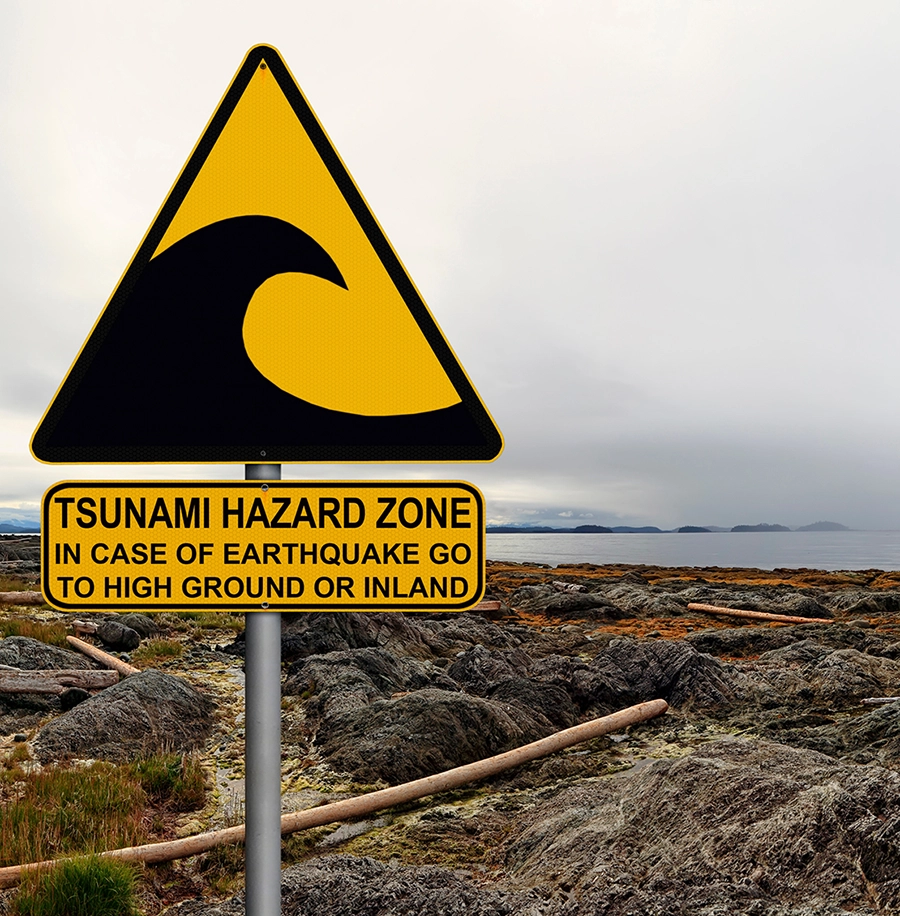
APPLICATIONS
- Earthquake Monitoring
- Earthquake and Tsunami early warning systems
- Oceanographic monitoring
- Environmental monitoring
- Cable integrity monitoring
- Offshore induced seismicity monitoring
APPLICATIONS

- Earthquake Monitoring
- Earthquake and Tsunami early warning systems
- Oceanographic monitoring
- Environmental monitoring
- Cable integrity monitoring
- Offshore induced seismicity monitoring

ITU-UNESCO/IOC-WMO
JOINT TASK FORCE
The advocacy for the SMART cable concept is currently led by the ITU-UNESCO/IOC-WMO Joint Task Force (“JTF”), established in 2012 by the United Nations to investigate the potential of using submarine telecommunications cables for ocean and climate monitoring and disaster warning. This Project is hosted by the Ocean Decade programme, Ocean Observing Co-Design: Evolving ocean observing for a sustainable future.
The JTF collaborates with a number of public and private organisations to assess and develop technologies that have the potential to make SMART cables feasible (Howe et al., 2022).
Güralp is proud to be driving instrumentation design in line with the current JTF vision.
The JTF collaborates with a number of public and private organisations to assess and develop technologies that have the potential to make SMART cables feasible (Howe et al., 2022).
Güralp is proud to be driving instrumentation design in line with the current JTF vision.
SMART CABLE JOINT TASK FORCE

ITU-UNESCO/IOC-WMO
JOINT TASK FORCE
The advocacy for the SMART cable concept is currently led by the ITU-UNESCO/IOC-WMO Joint Task Force (“JTF”), established in 2012 by the United Nations to investigatethe potential of using submarine telecommunications cables for ocean and climate monitoring and disaster warning. This Project is hosted by the Ocean Decade programme, Ocean Observing Co-Design: Evolving ocean observing for a sustainable future.
The JTF collaborates with a number of public and private organisations to assess and develop technologies that have the potential to make SMART cables feasible (Howe et al., 2022).
Güralp is proud to be driving instrumentation design in line with the current JTF vision.
The JTF collaborates with a number of public and private organisations to assess and develop technologies that have the potential to make SMART cables feasible (Howe et al., 2022).
Güralp is proud to be driving instrumentation design in line with the current JTF vision.
SMART CABLE DATA QUALITY
INITIAL SEISMIC DATA FROM FIRST CABLE DEPLOYMENT
The waveforms on the right were recorded by our seismic instrumentation shortly after they were deployed off the coast of Sicily in 2023 as part of the SMART cable wet demonstrator project. They show high quality seismic data for teleseismic, regional and local events.
TELESEISMIC EVENT
WEST COAST, EASTERN HONSHU, JAPAN
01/01/2024 07:10:13 Mwpd 7.4
01/01/2024 07:10:13 Mwpd 7.4
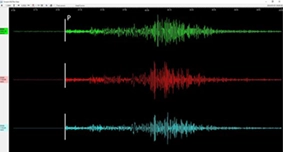
Waveform data: Repeater 1, (Certimus seismometer)

Waveform data: Repeater 1, (Fortimus accelerometer)
REGIONAL EVENT
WEST COAST CRETE,
GREECE
12/01/2024 03:51:07 Mb 4.7
GREECE
12/01/2024 03:51:07 Mb 4.7
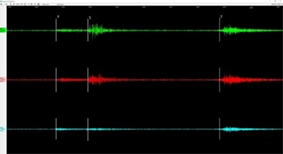
Waveform data: Repeater 2, (Certimus seismometer)
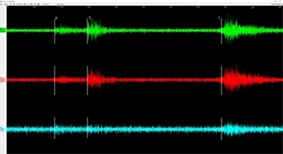
Waveform data: Repeater 2, (Fortimus accelerometer)
LOCAL EVENT
CATANIA COAST,
ITALY
14/01/2024 19:53:23 ML 2.0
ITALY
14/01/2024 19:53:23 ML 2.0
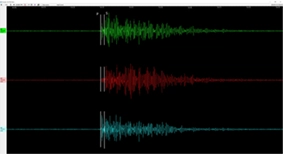
Waveform data: Repeater 3, (Certimus seismometer)
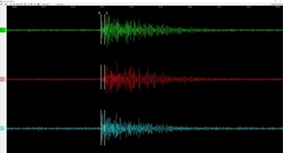
Waveform data: Repeater 3, (Fortimus accelerometer)
COMPARISONS WITH TRADITIONAL SEISMIC OBSERVATORY
A Güralp Orcus OBS was deployed at the same time as the SMART cable, as part of a broader InSEA project, in close proximity to the three repeaters. The Orcus station is part of the CALIPSO observatory.
Power Spectral Density (PSD) plots were created from the SMART cable Certimus units and from the CALIPSO system and compared.
Generally, the PSDs show close coherence, particularly out to a period of 20 seconds. This shows that a seismic sensor package using our omni-directional sensors installed in a repeater housing that has been deployed using a standard commercial method, provides comparable data quality to a dedicated offshore seismic observatory.
Power Spectral Density (PSD) plots were created from the SMART cable Certimus units and from the CALIPSO system and compared.
Generally, the PSDs show close coherence, particularly out to a period of 20 seconds. This shows that a seismic sensor package using our omni-directional sensors installed in a repeater housing that has been deployed using a standard commercial method, provides comparable data quality to a dedicated offshore seismic observatory.

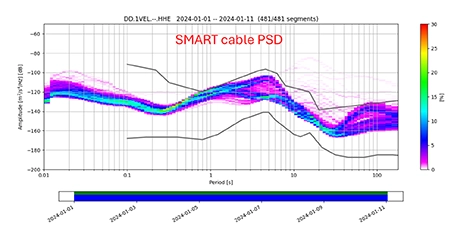
Want to know more?
Complete our enquiry form and one of our team will be in touch.
